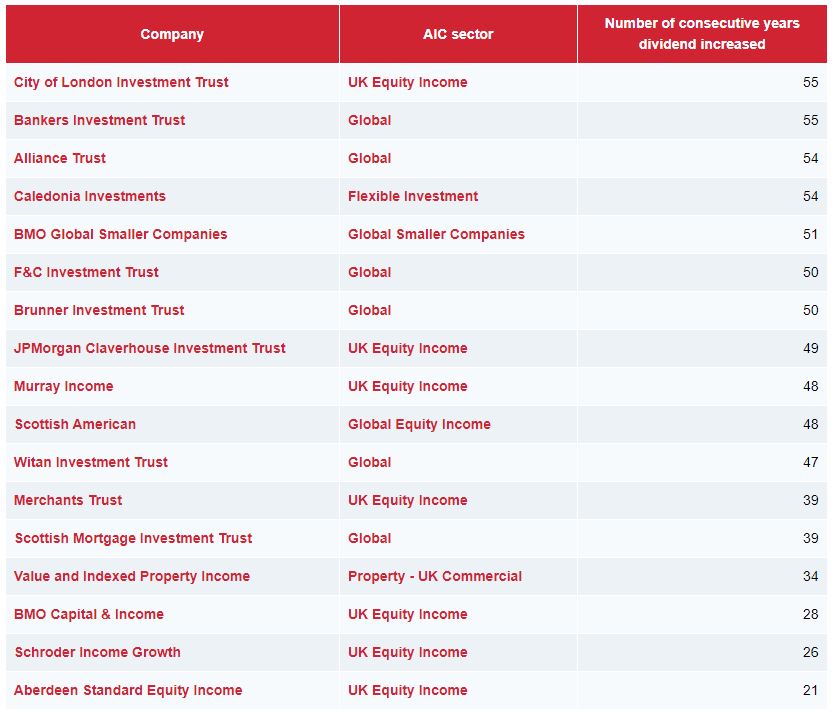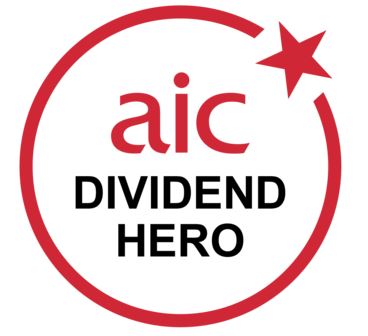This week, Brunner Investment Trust (BUT) reached a landmark 50 years of consecutive dividend increases after it announced a proposed final dividend of 6.05p in its annual results, taking the total for the year to 20.15p, up from 20.06p for the year before.
It joins only six other trusts that have achieved this success, including BMO Global Smaller Companies and Alliance Trust. City of London (CTY) and Bankers (BNKR) currently top the table, each boasting an impressive 55 years of consecutive dividend increases.
Protecting income for investors over the past two years, especially when traditional dividend-paying blue-chip companies were forced to suspend or cut their dividends, is a feat alone, let alone being able to increase that income.
Revenue reserves for rainy days
Of course, investment trusts have the advantage of being able to put income aside during strong years and then dip into those revenue reserves during hard times. The onset and fallout of the COVID pandemic has been one of the most difficult periods experienced by global economies since the financial crisis and perfectly highlights this benefit, which is unique to the closed-ended structure.
Having utilised 4.06p of its reserves in the prior accounting year, Brunner confirmed all dividends on ordinary shares for the year under review had been paid or are payable from the revenue it earned. This allowed it to begin to rebuild its revenue reserves, which are now equivalent to 24.7p per share.
BMO Global Smaller Companies was forced to dip into its reserves for the full year ended 30 April 2021, as its income fell sharply. Its revenue per share was down by 27.2%, as many companies suspended or re-based their dividend payments. However, this allowed the trust to reach a commendable 51 years of consecutive dividend increases.
As you can see from the names we have already mentioned, it’s not just equity income trusts that utilise this feature. In fact, of the Association of Investment Companies (AIC)’s 17 dividend heroes (trusts that have increased their dividend every year for 20 years or more) only eight sit within an equity income sector.
Meanwhile, trusts that rewarded investors during the pandemic were also not limited to traditional income-paying names. Over the past 12 months, we reported revenue reserves saving the day for a number of funds including Scottish Investment Trust, Aberdeen Latin American Income and JPMorgan UK Smaller Companies.

Source: The Association of Investment Companies
High yielding alternatives
Interestingly, while they don’t (yet) have dividend hero status, some of the best opportunities for income at the moment can be found among alternative asset classes.
The AIC reported that total trust dividends rose by 11% year-on-year over the first half of 2021, and while this certainly included names in the global equity income and UK equity income sectors, this figure was given a boost by alternative investment trusts.
As at 18 February 2022, the global equity income sector dividend yield offerings range from 2.56% to 5.49% (with a median of 3.71%) while the UK equity income sector offers a dividend range of 2.01% to a staggering 12.07% from British & American (note, this is somewhat of an anomaly and associated with some pretty awful capital returns – not one we’d recommend). The second-highest dividend yield stands at 5.93% while the median is just 4.21%.
However, looking at the trusts within the renewable energy infrastructure sector that pay a dividend (currently 17 out of 22), the dividend yield range is 3.17% to 7.13% while the median is 5.32%. The median dividend yield of trusts that pay income in the infrastructure sector is 4.73% and for the UK commercial property sector, it’s 4.87%.
Looking at these few figures as they stand today, the yields available from alternative investment trust sectors looks a lot more attractive than your traditional equity income trusts.
I’ll caveat this with the fact that these yields aren’t guaranteed to stay at these levels let alone deliver increases every year for the next 20 years (the criteria needed to become an AIC dividend hero).
